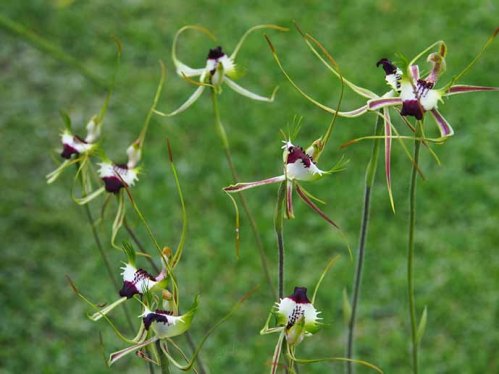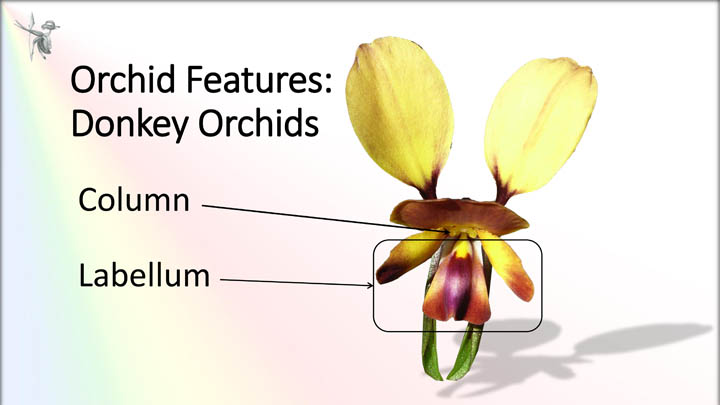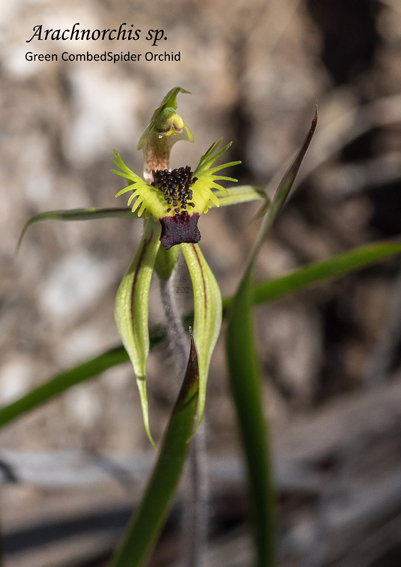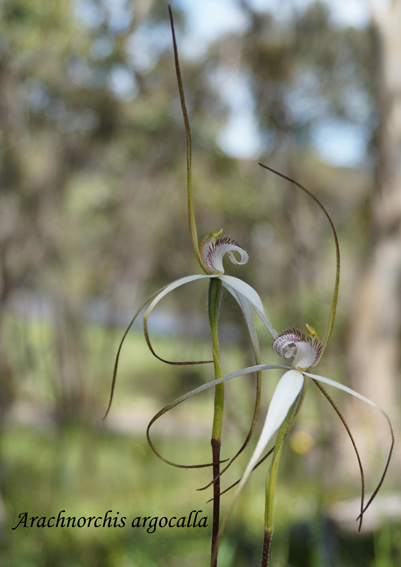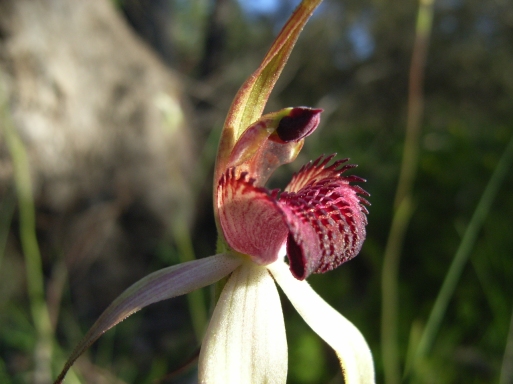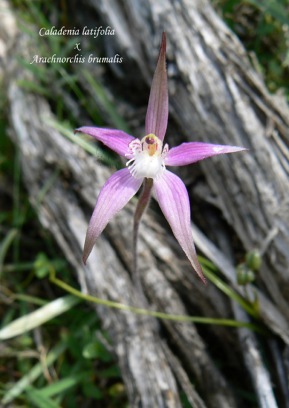One never knows what species will be entered each month – this month’s entries included Andrew Primer’s Eriochilus collinus, John Fennell’s Prasophyllum elatum, Marg Paech’s Pterostylis nutans and the winning picture, Pauline Meyer’s Arachnorchis sp. (which has subsequently been identified as Arachnorchis sp.)

In the last six years there have been over a dozen photo competition articles (the most recent April 2018) written on some aspects related to Spider Orchids. So, with another Spider Orchid winning the competition it is about time to answer the question – What Is A Spider Orchid?
Around the world, the common name Spider Orchid has been bestowed upon a number of orchids in different genera. In Australia, they have principally been applied to a large group within the genus Caladenia, a highly diverse cumbersome genus.
Caladenia in the broad sense is distinguished by erect flower stem and single linear, ovate to lanceolate leaf, (both hairy), labellum distinctly different from the other segments, generally fringed, curved and decorative calli. But within this genus it has been recognised for a long time that there are several distinct but varied groups, which has been reflected in the common names – Dragon, Pink Fingers, Hare, Spider, Wispy Spider, etc.
Consequently in 2001, several segregate genera were published including Arachnorchis for the common named Spider Orchids. This was not widely accepted, as reflected by the Herbaria of Australia. Indeed the original authors are no longer using the segregate names.
Yet despite all that, the segregate names have proved to be very practical for fieldwork. By using the segregate name when species is unknown, extra information is communicated. This was the case with Pauline’s picture. Yes she photographed a Caladenia but which one? It was an Arachnorchis species.
With that in mind, it is time to consider the features that make up a Spider Orchid or Arachnorchis.
In following through a dichotomous key Arachnorchis is immediately separated out from the rest of the Caladenia by the presence of two yellow waxy glands at the base of the column. As this is not the immediate feature seen, the following chart comparing it with the very similar looking Joneseopsis should assist with recognising some of the main distinguishing features.
| SPIDER ORCHIDS (ARACHNORCHIS) |
WISPY SPIDER OR DADDY LONG LEGS (JONESIOPSIS) |
|
| Leaf | Sparse to densely hairy Narrow to broad lanceolate Red base |
Sparsely hairy Slender Red base |
| Stem | Wiry densely hairy | Hairy wiry |
| Flower | ||
| Dorsal sepal | Erect | Erect |
| Tepals
(Petals & Sepals) |
Long & slender with long slender glandular tails or thickened short to long clubs*
Petals and sepals similar size |
Narrow, end in very long thin threadlike glandular tails* |
| Labellum | Trilobed obliquely erect lateral lobes Midlobe often differently coloured to the base |
Small indistinctly lobed
Narrow |
| Hinged | Hinged | |
| Apex | Rolled under at the apex | Rolls under* |
| Margins | Fringed with short to long teeth* | Short, blunt teeth to smooth |
| Calli | Vary from short rounded crowded to long curved and widely spaced | Short blunt congested lamina calli* |
| 2 or more rows | 2 rows* | |
| Basal Gland | 2 yellow at base of the column | None |
| Growth Habit | Loose groups* | Clumping |
*Exceptions in all these descriptions

Labelled Features of a Spider Orchid
Reference
Backhouse, G, (2018) Spider Orchids: The Genus Caladenia and Its Relatives in Australia ISBN: 978-0-9946489 Electronic version
Bates, R. J., ed. (2011). South Australian Native Orchids. Electronic version, 2011. NOSSA
Jones, D. L., A Complete Guide to Native Orchids of Australia Including the Island Territories. Reed New Holland
Jones, D. L.; Hopely, T; Duffy, S. M.; Richards, K. J.; Clements, M. A and Zhang X, Australian Orchid Genera an information and identification system. Electronic version, 2006, CSIRO


